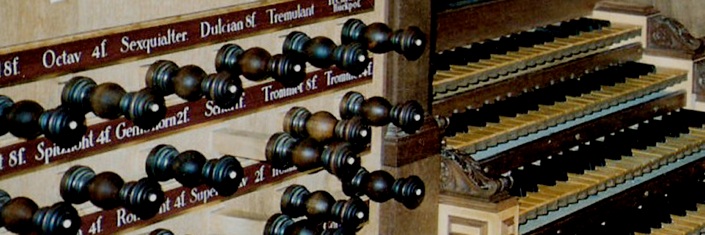LUCA BENEDICTI





Sometimes vibration is clearer than sound
Concert in St John Church on the Muhleisen-Orgel: Luca Benedicti from Turin and his new tunes
Article from Leonberg Kreiszeitung 02/05/2009
Leonberg. Every organ concert in the catholic church of St John underlines new features of the instrument as made intelligible by the player and by the different pieces. On Wednesday the organist from Turin Luca Benedicti has played works of the XIX century.
By Gabriele Muller
The Italian artist always employs strong and powerful pedal stops. It is only the ear that can perceive them, but the whole body is involved. Sometimes the internal vibration is even more relevant than what the listener can hear. The artist from Torino employs often the swell and realizes very quickly a great series of dynamical variations.
The Muhleisen-Orgel seems to have been conceived for pieces from the Romantic age. Luca Benedicti, who teaches organ and composition at the City Musical Institute of Busca, uses all its palette of musical tones and fully exploits the potentiality of this king of instruments. Already the first piece, the Sonata n. 1 in D Minor by Marco Enrico Bossi, justifies that the organ in St John is worth this appreciation. The dense and heavy notes resound majestic while the loud tones build powerful foundations over which an impressive musical monument arises.
The second movement opens in this drastic way. The quiet, pleasant and almost shy Ductus follows as a thoughtful rest after the dreadful storm. To use a metaphor from the atmosphere, one can always perceive soft clouds crossed by sharp lines, and this carries at the same time open contrasts and relaxations. The final toccata throb in a more and more violent and dynamical way and also the loud tones appear again. The music shines in all its light.
The “Cantabile” by César Franck introduces in a dreaming atmosphere. The melody develops itself windingly over very slow tunes and immediately after the two voices interchange their roles. This work shows a calm and quiet character.
The “Adagio per voce umana” by Vincenzo Petrali from his Sonata per l’Offertorio reveals an even more quiet mood and allows to discover the stops and more bulky stops.
The Allegro from the Symphony n. 2 op. 20 in E minor by Louis Vierne gives rise to a great contrast. The basic character of this piece is troubled and nervous. The powerful bass stops are heard again and Benedicti is able once more to generate effects that look spectral and frightening. The final chord cannot be forgotten and seems to be never ended.
A lyric piece follows, the “Andante cantabile” from the Symphony n. 4 in f minor op. 13 by Charles-Marie Widor. The light and subtle sounds seem to arrive from far, then suddenly everything becomes loud and the audience is dismayed. The stops change again, but a sunny atmosphere is left.
All the stops literarily come to play in the final piece. In his “Hommage à Haendel” Sigfried Karg-Elert wrote “54 studies in Variation form in around bass from Haendel”. The beginning of this work is hollow and measureless, the effect of the vibrations is more powerful than the sound and the low pipes of the organ have again the most important role. Each of the short and bare variations bears its own character. The joy of the artist who makes the most of the shades of sound for playing is never exhausted and the audience is lead to discover many unknown features of the organ.









